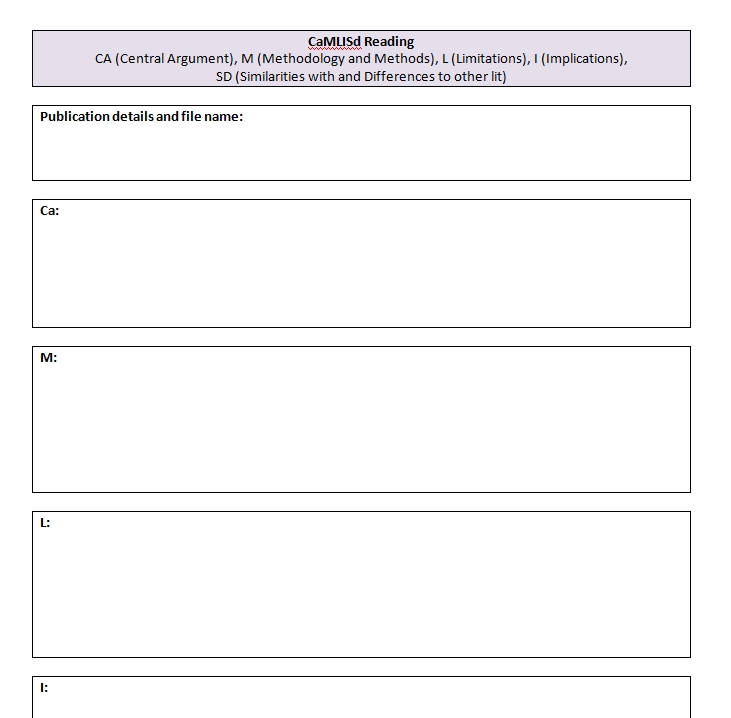
Source: N Brown
Practice-based enquiries or research projects usually start out with a spark of an idea, but then you need to take systematic steps towards a balanced literature review. Once you have an idea, you should start reading around that topic area. However, if you read a great range of articles you may find that you cannot remember who said what when and where. Therefore, a systematic approach to reading and taking notes is necessary. For you to be able to use your notes within the literature review you need to make sure you read and write in a critical and reflective manner. So in addition to the details about the publication your notes should cover your thoughts in your own words relating to the methods and methodology used in your chosen publication and the key ideas and implications that are presented, for example. It may be helpful to apply the “CaMLISd” grid, which can be downloaded from here.
Ca – central argument:
Ask yourself what the key message is that is conveyed and what the author is trying to communicate.
M – methodology and methods:
Comment on the methodology and methods used in the article. Are they clear and relevant? Could or should they be different in another context? How are the methodological approaches helping to answer the research questions? Are the methods suitable and free from bias?
L – limitations:
This leads on directly from the M aspect of your reading, and you will find that there may be some limitations to the studies you read about.
I – implications:
Considering all the previous sections you should now ask yourself about the implications of the study and the recommendations the author makes. What do the outcomes and recommendations mean in general terms and more specifically for you and your own research?
Sd – similarities with and differences to other literature
This part of your note-taking is more difficult than the others, as you are starting to make links to other readings. However, if you do it well at this stage, then typing up the entire literature review will be much easier, as the key ideas are already referenced.
Two more rules about note-taking:
- Publication details:
Get used to the correct referencing standards early on and apply them when you are taking notes. You should make clear notes of the names of the author, the publication, the publishing company, the location and date of the publication. At this stage it may seem laborious having to write all these details down, but trying to locate a publication and page number at a later stage because some details are incorrect or missing is by far more time-consuming and frustrating. If you are saving your articles electronically on your computer, it is also a good idea to write down the file name on your CaMLISd grid, so you will find it again.
- Your own words:
Whenever possible use your own words for completing the CaMLISd grid. By using your own words you demonstrate your understanding of what you have read and at the same time you take your first step towards avoiding plagiarism. If there are some key phrases that you would like to use as a direct quotation, copy the words and formats exactly and make a note of the page number you refer to, as you will need this information for your in-text referencing in your literature review.
[…] Short-term plan:This is your schedule for the term. Identify the most important dates and deadlines you need to adhere to and highlight those in your termly schedule. This should then help you plan revision and editing times within your weekly schedule. For example, one week before your assignment is due you should only factor in minor editing and proofing work. Two weeks before the essay deadline you should start the proofing process by reading your work critically as if it was somebody else’s work. At the beginning of each term, you can start looking at the coursework requirements for the modules you are enrolled in. In some cases, you may be given a date when you will be informed of the coursework details. If this is true for your module you should start reading literature that is core to the course as well as any related publications. Even if you are not able to start drafting ideas, you will have gained content knowledge that will make your writing easier. See here for how to read literature systematically. […]
When I started my PhD, I’ve created my own version of this systematic reading and even I don’t know what should it be called. However, I found this one is more detailed and comprehensive, but I just add the findings of the study, so I can compare my research findings to the others’s.
Thank you, Wafa. Adding the findings could be very important depending on your field of study. Where it is relevant I write details about findings and data within the reading notes. “CaMLISd” is a good way of reminding myself of what it is I am looking for, when I’m reading.